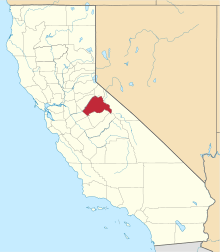Pinecrest, Tuolumne County, California
| Pinecrest, California | |
|---|---|
| Unincorporated community | |
 Pinecrest, California | |
| Coordinates: 38°11′19″N 119°59′27″W / 38.18861°N 119.99083°WCoordinates: 38°11′19″N 119°59′27″W / 38.18861°N 119.99083°W | |
| Country | United States |
| State | California |
| County | Tuolumne |
| Elevation | 5,679 ft (1,731 m) |
| Time zone | Pacific (PST) (UTC-8) |
| • Summer (DST) | PDT (UTC-7) |
| Area code(s) | 209 |
| GNIS feature ID | 1659782[1] |
Pinecrest is an unincorporated community in Tuolumne County, California, United States. Pinecrest is located near Pinecrest Lake northwest of Mi-Wuk Village. Pinecrest Lake sits in what was once a meadow surrounded by granite outcroppings. Originally, Pinecrest Lake was called Strawberry Flat because of the wild strawberries that once grew there. In the 1960s the name was officially changed to Pinecrest. The campground adjacent to the lake is under the white fir, cedar, and sugar pine trees.
Pinecrest Lake is the last in a series of dams constructed on the South Fork of the Stanislaus River. In the beginning the purpose was to divert water via ditches and flumes to the mining claims in and around Columbia and the foothills. Much of this aqueduct system remains intact today and is still used as a portion of the main water system for the surrounding area. A large part of the aqueduct in the forest was built with wooden flumes, builders carried portable sawmills into the forest to mill the trees into boards in order to construct the flumes. The present dam at Pinecrest, previously called Lower Strawberry Reservoir Dam, was built by Sierra and San Francisco Power Company for hydroelectric power, the water is managed by Tuolumne Utilities District (TUD).
Pinecrest History
Prior to the California Gold Rush of 1848 anthropologists agree that the first inhabitants of Pinecrest were the early bands of Me-Wuk Indians. History shows that the area which is now Pinecrest was used by the Me-Wuks as a trading ground. Scattered throughout the forest you can still find evidence of ancient grinding rocks used by the Me-Wuks in areas assumed to be their campsites. As the Gold Rush began the Me-Wuks were treated poorly by the early settlers; leading to the diminishing numbers of Me-Wuk Indians. Over time miners and settlers began searching for new opportunities. Soon, logging became a major industry in the area. With logging came the development of many foothill towns. Water was vital to the survival of these towns. Many lakes, such as Pinecrest were developed in order to sell and provide water to the foothill towns.
The U.S. Forest Service's Summit Ranger District station, is a mile from Pinecrest Lake. You can visit them and get information about a little trail across the street that winds through a few bark teepees. Pinecrest has a post office with ZIP code 95364.[2] The post office was established in 1917 and briefly closed from 1921 to 1923.[3]
References
- ↑ U.S. Geological Survey Geographic Names Information System: Pinecrest, Tuolumne County, California
- ↑ ZIP Code Lookup
- ↑ Durham, David L. (1998). California's Geographic Names: A Gazetteer of Historic and Modern Names of the State. Quill Driver Books. p. 815. ISBN 1-884995-14-4.
